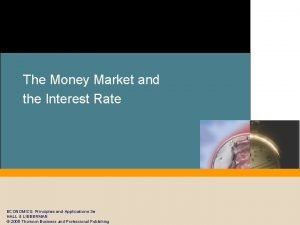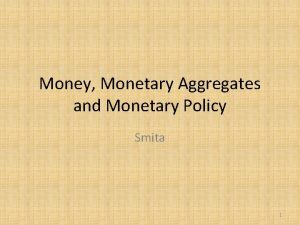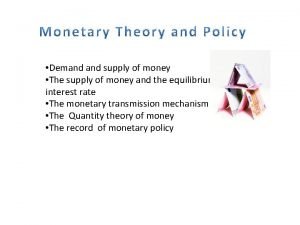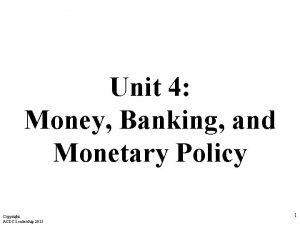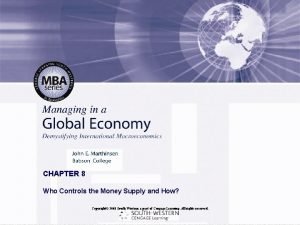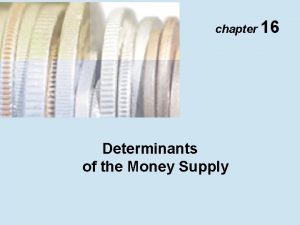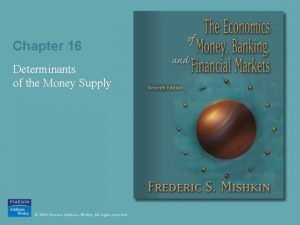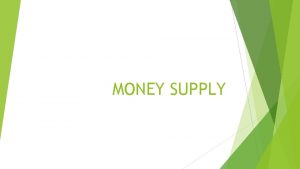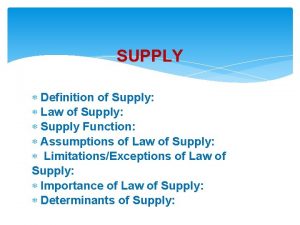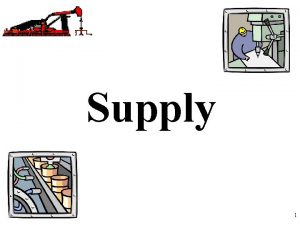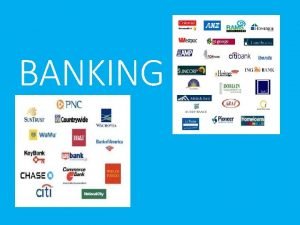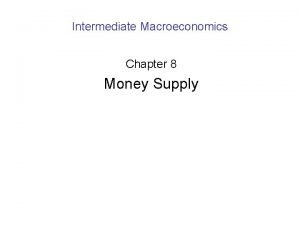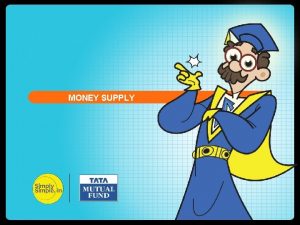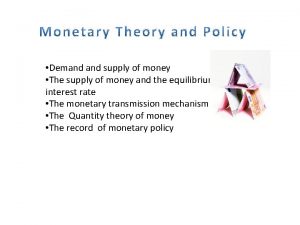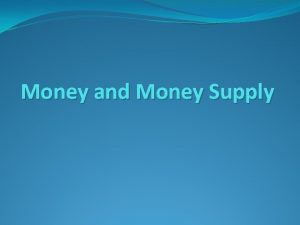Money and the Money Supply Money and the











- Slides: 11

Money and the Money Supply

Money and the Money Supply �Money: Anything that is generally accepted as final payment for goods and services �MONEY SERVES THESE PURPOSES: �Medium of exchange: It can be used to purchase goods and services �Unit of Account: It can be used to compare the value of different goods and services �Store of Value: It can be held to buy something in the future

MONEY SUPPLY �Narrowly defined by economists as currency (coins and paper money) in the hands of the public, plus checking-type accounts. Currency makes up about 48% of the total, and checking-type accounts about 52%. �The supply of money in the economy is important for price stability and economic growth �Too much money in the economy can cause inflation. An extreme example of this occurred in Germany after World War I, when the German government printed so much money that prices increased 5470% in 1923.

MONEY SUPPLY �Too little money in the economy can lead to falling prices and falling production. An example of this occurred in the U. S. between 1929 and 1933. The money supply fell by 30%, and most economists agree that this was a major cause of the Great Depression. �The Federal Reserve controls the money supply through monetary policy. Monetary policy works through encouraging or discouraging banks from making loans. �STOP

MONEY SUPPLY �Round 1: Money Supply = 60 Bean � 60 Beans are circulating as money in the economy. �STOP

ROUND 2 �MONEY SUPPLY = 60 BEANS � 50 Beans plus 10 Bank Deposit Receipts are in circulation. �Both Bank Deposit Receipts and beans are accepted as currency �STOP

ROUND 3 � 50 Beans plus 15 Bank Deposit Receipts are in circulation. Both Bank Deposit Receipts and beans are accepted as money.

THE FEDERAL RESERVE SYSTEM �The Fed was created in 1914 after a series of bank failures �The Fed Board of Governors: � 7 members appointed by the President, with confirmation by the Senate �Board members serve 14 -year terms �President appoints the chairperson to a 4 -year term. � 12 Regional Federal Reserve Banks: �Regional banks are located in major cities around the country �Each bank has a president chosen by the bank’s board of directors �The board of directors is typically drawn from the local business and banking community

THE FEDERAL RESERVE AND MONETARY POLICY �FEDERAL RESERVE (THE FED): �The U. S. central banking system. One of the functions of the Fed is to control the money supply through monetary policy. �MONETARY POLICY �Changes in the money supply, intended to maintain stable prices, full employment and economic growth �If the Fed is fighting unemployment and declining GDP, it wants to increase the money supply �If the Fed is fighting inflation, it wants to decrease the money supply

THE FEDERAL RESERVE AND MONETARY POLICY �TOOLS OF MONETARY POLICY �Open Market Operations �When the Fed buys or sells U. S. government securities to influence the money supply �When the Fed buys securities, bank deposits increase, banks have more money to lend, and the money supply increases. �When the Fed sells securities, bank deposits decrease, banks have less money to lend, and the money supply decreases. �Changes in the Discount Rate �The discount rate is the interest rate that the Fed charges on loans to banks �When the Fed lowers the discount rate, banks are encouraged to make more loans and the money supply increases. �When the Fed raises the discount rate, banks are discouraged from making loans and the money supply decreases.

THE FEDERAL RESERVE AND MONETARY POLICY �Changes in the Reserve Requirement �The reserve requirement is the minimum percentage of deposits that banks must keep on reserve to back up checking-type accounts �When the Fed lowers the reserve requirement, banks have more money to lend and the money supply increases. �When the Fed raises the reserve requirement, banks have less money to lend and the money supply decreases. �HOMEWORK!
 Money money money team
Money money money team Chapter 5 section 1 supply and the law of supply
Chapter 5 section 1 supply and the law of supply Matching supply and demand in supply chain
Matching supply and demand in supply chain Ang elastisidad ng supply ay?
Ang elastisidad ng supply ay? Money market equilibrium
Money market equilibrium Liquidity adjustment facility
Liquidity adjustment facility Money supply and demand graph
Money supply and demand graph Decreasing money supply
Decreasing money supply What exactly is money?
What exactly is money? Who controls the money supply
Who controls the money supply Chapter 16 determinants of the money supply
Chapter 16 determinants of the money supply Chapter 16 determinants of the money supply
Chapter 16 determinants of the money supply




